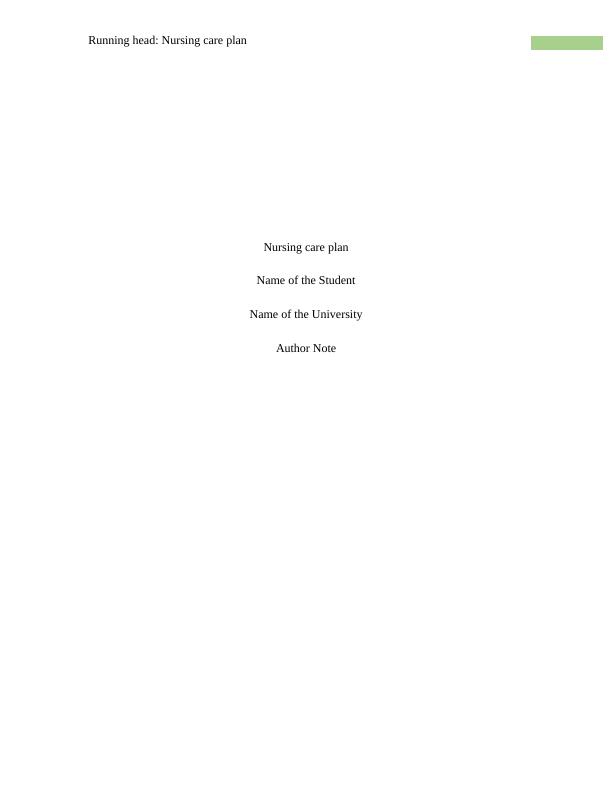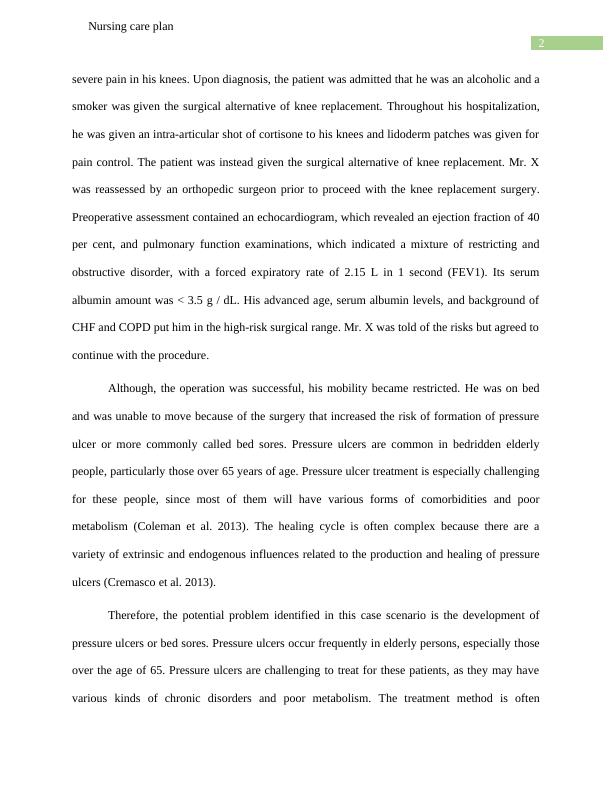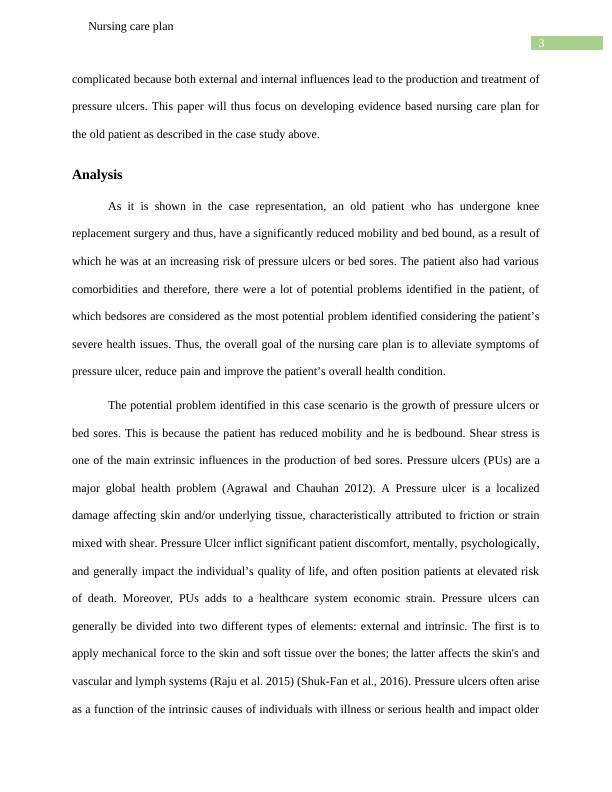Evidence of Nursing Care Plan
16 Pages5147 Words12 Views
Added on 2022-08-18
Evidence of Nursing Care Plan
Added on 2022-08-18
ShareRelated Documents
Running head: Nursing care plan
Nursing care plan
Name of the Student
Name of the University
Author Note
Nursing care plan
Name of the Student
Name of the University
Author Note

1
Nursing care plan
Introduction
Medical workers are challenged to prevent skin damage to peri-operative surroundings
due to prolonged patient immobility, anesthesia impairments of the circulatory functions, and
many surgical populations' pre-existing conditions. These injuries can lead to prolonged
hospitalization, increased medical expenses and prolonged morbidity (Aygör et al. 2014). The
healthcare facility may also face financial and legal consequences for such injuries. Below is the
case-representation of an elderly individual who had undergone knee replacement surgery and
thus, had substantially diminished mobility and bound bed, as a consequence of which he was at
a growing risk of ulcers or bed sores (Coleman et al. 2013). The patient often has multiple
comorbidities and, as a consequence, there were several possible issues found in the individual,
in which bedsores are known to be the most probable issue found in the sense of the significant
health concerns of the individual. In a consequence, the ultimate aim of the nursing care program
is to minimize severity of pressure ulcers, alleviate discomfort and improve general wellbeing
patient. This paper will thus focus on developing evidence based nursing care plan for the old
patient as described in the case study.
Description
Case scenario:
Mr. X, a 72-year-old man with a history of serious left knee arthritis, was treated after a
severe fall and extreme discomfort in his right knee. His medical history included degenerative
joint disease of knees, cirrhosis, congestive heart failure (CHF), interstitial lung disease,
hypertension, atrial fibrillation, s / p pacemaker, and chronic obstructive pulmonary disease
(COPD) with home oxygen. He had current hospitalizations due to mechanical falls followed by
Nursing care plan
Introduction
Medical workers are challenged to prevent skin damage to peri-operative surroundings
due to prolonged patient immobility, anesthesia impairments of the circulatory functions, and
many surgical populations' pre-existing conditions. These injuries can lead to prolonged
hospitalization, increased medical expenses and prolonged morbidity (Aygör et al. 2014). The
healthcare facility may also face financial and legal consequences for such injuries. Below is the
case-representation of an elderly individual who had undergone knee replacement surgery and
thus, had substantially diminished mobility and bound bed, as a consequence of which he was at
a growing risk of ulcers or bed sores (Coleman et al. 2013). The patient often has multiple
comorbidities and, as a consequence, there were several possible issues found in the individual,
in which bedsores are known to be the most probable issue found in the sense of the significant
health concerns of the individual. In a consequence, the ultimate aim of the nursing care program
is to minimize severity of pressure ulcers, alleviate discomfort and improve general wellbeing
patient. This paper will thus focus on developing evidence based nursing care plan for the old
patient as described in the case study.
Description
Case scenario:
Mr. X, a 72-year-old man with a history of serious left knee arthritis, was treated after a
severe fall and extreme discomfort in his right knee. His medical history included degenerative
joint disease of knees, cirrhosis, congestive heart failure (CHF), interstitial lung disease,
hypertension, atrial fibrillation, s / p pacemaker, and chronic obstructive pulmonary disease
(COPD) with home oxygen. He had current hospitalizations due to mechanical falls followed by

2
Nursing care plan
severe pain in his knees. Upon diagnosis, the patient was admitted that he was an alcoholic and a
smoker was given the surgical alternative of knee replacement. Throughout his hospitalization,
he was given an intra-articular shot of cortisone to his knees and lidoderm patches was given for
pain control. The patient was instead given the surgical alternative of knee replacement. Mr. X
was reassessed by an orthopedic surgeon prior to proceed with the knee replacement surgery.
Preoperative assessment contained an echocardiogram, which revealed an ejection fraction of 40
per cent, and pulmonary function examinations, which indicated a mixture of restricting and
obstructive disorder, with a forced expiratory rate of 2.15 L in 1 second (FEV1). Its serum
albumin amount was < 3.5 g / dL. His advanced age, serum albumin levels, and background of
CHF and COPD put him in the high-risk surgical range. Mr. X was told of the risks but agreed to
continue with the procedure.
Although, the operation was successful, his mobility became restricted. He was on bed
and was unable to move because of the surgery that increased the risk of formation of pressure
ulcer or more commonly called bed sores. Pressure ulcers are common in bedridden elderly
people, particularly those over 65 years of age. Pressure ulcer treatment is especially challenging
for these people, since most of them will have various forms of comorbidities and poor
metabolism (Coleman et al. 2013). The healing cycle is often complex because there are a
variety of extrinsic and endogenous influences related to the production and healing of pressure
ulcers (Cremasco et al. 2013).
Therefore, the potential problem identified in this case scenario is the development of
pressure ulcers or bed sores. Pressure ulcers occur frequently in elderly persons, especially those
over the age of 65. Pressure ulcers are challenging to treat for these patients, as they may have
various kinds of chronic disorders and poor metabolism. The treatment method is often
Nursing care plan
severe pain in his knees. Upon diagnosis, the patient was admitted that he was an alcoholic and a
smoker was given the surgical alternative of knee replacement. Throughout his hospitalization,
he was given an intra-articular shot of cortisone to his knees and lidoderm patches was given for
pain control. The patient was instead given the surgical alternative of knee replacement. Mr. X
was reassessed by an orthopedic surgeon prior to proceed with the knee replacement surgery.
Preoperative assessment contained an echocardiogram, which revealed an ejection fraction of 40
per cent, and pulmonary function examinations, which indicated a mixture of restricting and
obstructive disorder, with a forced expiratory rate of 2.15 L in 1 second (FEV1). Its serum
albumin amount was < 3.5 g / dL. His advanced age, serum albumin levels, and background of
CHF and COPD put him in the high-risk surgical range. Mr. X was told of the risks but agreed to
continue with the procedure.
Although, the operation was successful, his mobility became restricted. He was on bed
and was unable to move because of the surgery that increased the risk of formation of pressure
ulcer or more commonly called bed sores. Pressure ulcers are common in bedridden elderly
people, particularly those over 65 years of age. Pressure ulcer treatment is especially challenging
for these people, since most of them will have various forms of comorbidities and poor
metabolism (Coleman et al. 2013). The healing cycle is often complex because there are a
variety of extrinsic and endogenous influences related to the production and healing of pressure
ulcers (Cremasco et al. 2013).
Therefore, the potential problem identified in this case scenario is the development of
pressure ulcers or bed sores. Pressure ulcers occur frequently in elderly persons, especially those
over the age of 65. Pressure ulcers are challenging to treat for these patients, as they may have
various kinds of chronic disorders and poor metabolism. The treatment method is often

3
Nursing care plan
complicated because both external and internal influences lead to the production and treatment of
pressure ulcers. This paper will thus focus on developing evidence based nursing care plan for
the old patient as described in the case study above.
Analysis
As it is shown in the case representation, an old patient who has undergone knee
replacement surgery and thus, have a significantly reduced mobility and bed bound, as a result of
which he was at an increasing risk of pressure ulcers or bed sores. The patient also had various
comorbidities and therefore, there were a lot of potential problems identified in the patient, of
which bedsores are considered as the most potential problem identified considering the patient’s
severe health issues. Thus, the overall goal of the nursing care plan is to alleviate symptoms of
pressure ulcer, reduce pain and improve the patient’s overall health condition.
The potential problem identified in this case scenario is the growth of pressure ulcers or
bed sores. This is because the patient has reduced mobility and he is bedbound. Shear stress is
one of the main extrinsic influences in the production of bed sores. Pressure ulcers (PUs) are a
major global health problem (Agrawal and Chauhan 2012). A Pressure ulcer is a localized
damage affecting skin and/or underlying tissue, characteristically attributed to friction or strain
mixed with shear. Pressure Ulcer inflict significant patient discomfort, mentally, psychologically,
and generally impact the individual’s quality of life, and often position patients at elevated risk
of death. Moreover, PUs adds to a healthcare system economic strain. Pressure ulcers can
generally be divided into two different types of elements: external and intrinsic. The first is to
apply mechanical force to the skin and soft tissue over the bones; the latter affects the skin's and
vascular and lymph systems (Raju et al. 2015) (Shuk-Fan et al., 2016). Pressure ulcers often arise
as a function of the intrinsic causes of individuals with illness or serious health and impact older
Nursing care plan
complicated because both external and internal influences lead to the production and treatment of
pressure ulcers. This paper will thus focus on developing evidence based nursing care plan for
the old patient as described in the case study above.
Analysis
As it is shown in the case representation, an old patient who has undergone knee
replacement surgery and thus, have a significantly reduced mobility and bed bound, as a result of
which he was at an increasing risk of pressure ulcers or bed sores. The patient also had various
comorbidities and therefore, there were a lot of potential problems identified in the patient, of
which bedsores are considered as the most potential problem identified considering the patient’s
severe health issues. Thus, the overall goal of the nursing care plan is to alleviate symptoms of
pressure ulcer, reduce pain and improve the patient’s overall health condition.
The potential problem identified in this case scenario is the growth of pressure ulcers or
bed sores. This is because the patient has reduced mobility and he is bedbound. Shear stress is
one of the main extrinsic influences in the production of bed sores. Pressure ulcers (PUs) are a
major global health problem (Agrawal and Chauhan 2012). A Pressure ulcer is a localized
damage affecting skin and/or underlying tissue, characteristically attributed to friction or strain
mixed with shear. Pressure Ulcer inflict significant patient discomfort, mentally, psychologically,
and generally impact the individual’s quality of life, and often position patients at elevated risk
of death. Moreover, PUs adds to a healthcare system economic strain. Pressure ulcers can
generally be divided into two different types of elements: external and intrinsic. The first is to
apply mechanical force to the skin and soft tissue over the bones; the latter affects the skin's and
vascular and lymph systems (Raju et al. 2015) (Shuk-Fan et al., 2016). Pressure ulcers often arise
as a function of the intrinsic causes of individuals with illness or serious health and impact older

End of preview
Want to access all the pages? Upload your documents or become a member.
Related Documents
NUR250 Medical Surgical Nursing 2 Assessment 1lg...
|17
|4271
|475
Nursing Case Study Assignment Samplelg...
|5
|991
|83
Nursing Assessment for COPD Exacerbationlg...
|15
|3688
|71
NUR250 Medical Surgical Nursing 2 Assessment 1lg...
|13
|4369
|2
Clinical Reasoning Cycle for Mr Cyril Smith's Caselg...
|4
|1568
|44
NUR250 Medical Surgical Nursing 2 Assessment 1lg...
|10
|3595
|447
